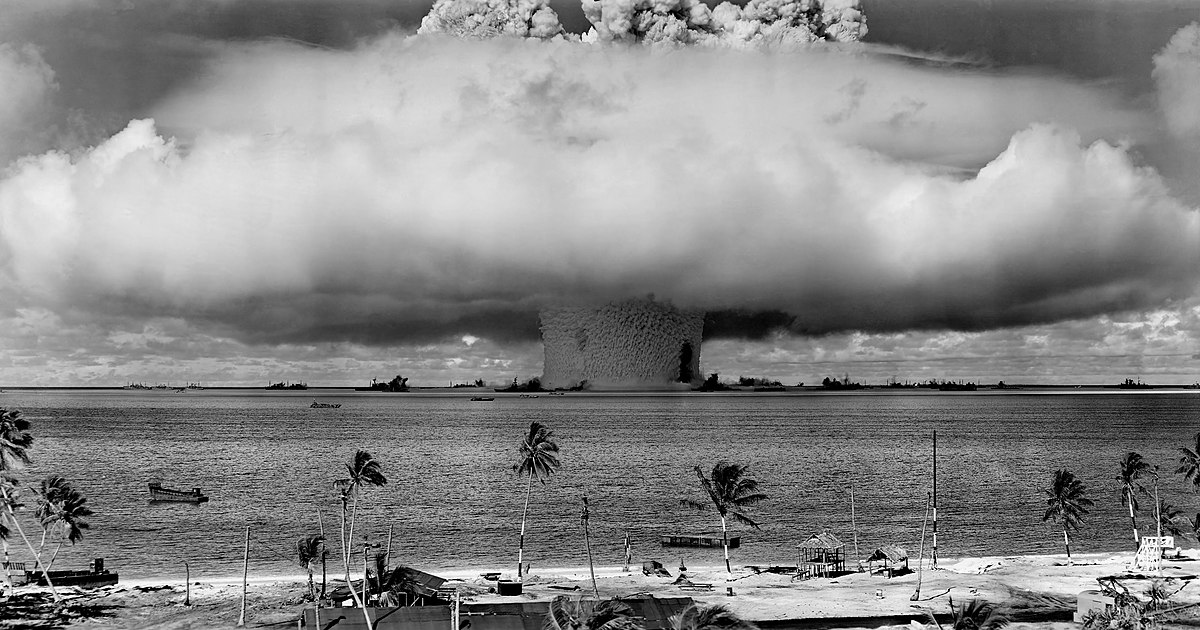
“Operation Crossroads Baker Edit” by United States Department of Defense (either the U.S. Army or the U.S. Navy) derivative work: Victorrocha (talk) – Operation_Crossroads_Baker_(wide).jpg. Licensed under Public Domain via Commons.
Micronesia is a sub-region of Oceania which encompasses several Pacific Island nations including the Federated States of Micronesia (FSM), Kiribati, Marshall Islands, Chuuk Islands, and Nauru as well as the United States territories of Guam, Wake Island, and Northern Marina Islands. From 1947-1986, much of the region was designated as part of the Trust Territory of the Pacific Islands and was controlled by the United States Navy as a “strategic area”. During WWII the US established military bases in the region and used the islands as nuclear testing sites. The source presented here pictures one of many blasts at Bikini Atoll in the Marshall Islands. Long standing and frequent blast testing here over the past six decades has resulted in radioactive contamination of the surrounding waters and lands, making Bikini Atoll uninhabitable. When the U.S. military arrived in Marshall Islands, Bikinians were forced to migrate to the nearby islands of Kili and Ejit, where today, a second wave of of migration from the region is being forced by the devastating affects of climate change. Radioactive fallout from nuclear testing has since continued to pose serious implications for the people of Micronesian nations, many of whom lead subsistence lifestyles. Nuclear activity has rendered entire populations of fish – a staple of the Micronesian diet- contaminated and lifeless. Food scarcity and economic hardship drive migration within the region, as Micronesian nations now experience some of the highest number of emigrants per capita worldwide. Micronesian emigration to the United States is made possible under the Compact of Free Association (COFA) – an agreement that governs the relationship between the United States, Marshall Islands, and FSM. The compact allows the United States continued military access to the region, and in exchange, COFA nations receive aid from the US, and citizens are afforded benefits like the right to relocate to the United States freely and enjoy access to health care, education, etc. COFA cleared the way for free movement of Pacific islanders to the United States, but the agreement does not do much to explain the readiness of such massive numbers of citizens to leave Micronesia. It is true that climate change and radioactive damage serve as a strong push factors for migrating islanders in the region, but according to the Migration Policy Institute, U.S. policies in the 1970s and 1980s also influenced out-movement of Micronesians. For example, in the 1970s the U.S. government provided aid to the FSM to establish a wage economy to replace its subsistence economy. Next, the notion of universal education for Micronesian citizens turned out an increased number of high school and university graduates who moved to find work. Finally, after FSM declared its independence, the decision on behalf of the U.S. to reduce funding to the island nation quickly shrunk the economy, causing job loss and further movement of people’s seeking financial opportunity. When we consider the merging point between nuclear tests at sites like Bikini Atoll, the subsequent signing of COFA, and the policies of the United States to follow, we are better equipped to understand one of the prevailing circumstances that pushes Micronesian peoples to emigrate by the masses from their once idyllic homelands.
This 1946 photo taken at Bikini Atoll was created by the United States Department of Defense and depicts nuclear testing in the midst of Cold War era tensions, its likely purpose was to document nuclear happenings on Marshall Islands. At the time of its taking, this photo probably represented military dominance of the United States on the world’s stage, and may have even been perceived as a symbol of U.S. strength. Now, we are beginning to understand how the consequences of nuclear activity have had a lasting impact on people living near these test sites, driving economic instability, food insecurity, and as a result- migration. It is important to consider the bias of this source. The image is raw and captivating, and demonstrative of a kind of military dominance that is capable of total eradication. Not pictured here, however, are the impacts of such displays of military power. There is nary a human being in this photo, perhaps creating the illusion that these tests are constructed on deserted islands rather than ones inhabited by populations who have been severely affected by this kind of military activity. This source could help historians to understand how U.S. nationalist agendas during WWII and the Cold War had a profound and lasting impact on migration patterns of Micronesian peoples.
Jacquelyn Dupont
